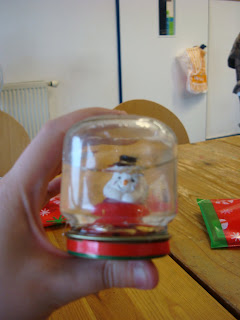The 4th graders have been learning about the different birds all over the world. They have been studying their habitat, where they live, and distinct characteristics about birds. For their project they selected a bird and presented it to the class.
Ian chose the Snowy Owl. Ian chose the Snowy Owl because he wanted to learn more about this bird, he also likes Harry Potter so he has become familiar with the Owl from the movies.
Here are some facts about the Snowy Owl:
Scientifically known as the Bubo scandiacus, the snowy owl is also known as the Arctic Owl or the Great White Owl. These are the heaviest of owls in North America and breed on the Arctic tundra. These beautiful snowy owls are found in Greenland, Iceland, Canada and the Northern parts of USA. This large bird has a rounded head with yellow eyes and a black bill. The overall plumage is speckled with thin and horizontal bars or spots. The male snowy owl’s plumage is almost purely white where as the adult females have around four to six tail bands. These owls are around 53-65 cms in length and have a wingspan of around 125-150 cms. The young snowy owls are uniformly brown. They also have scattered tips of white. The snowy owl does perch in trees but is known to live in hollowed out holes. This bird very rarely travels into the forest areas. They mainly are spotted in open grasslands, along lakeshores, marshes and marine coastlines. Many snowy owls migrate to the Great Plains of Canada around November and leave this area around March. Amongst the important snowy owl facts, one would be that they are diurnal. This would simple mean unlike other owls; the snowy owls are active and hunt during the nighttime as well as the daytime. They are known to have a strong and steady flight with very powerful strokes. This species nests on the ground by building a scrape on top of a boulder. They also make short flights, which are close to the ground in the hunt for food. The voice of the snowy owls varies. During the non-breeding season, they are relatively silent. The male snowy owl has a typical call, which is very harsh and sounds like a bark. The female snowy owl has a higher pitched call. When it time for the mating season, the male snowy owls have a loud and booming sound. These are also known to clap their beaks when annoyed. Young ones are known to ‘cheep’ for at least the first 2 weeks.
The diet of the snowy owl consists of lemmings and rodents. These owls are known to sit and wait for their prey. They can capture the prey on the ground, in the air or they are known to grab them even on the surface of the water bodies. Snowy owls use their beaks or their talons to weaken the prey.
Their courtship behavior generally begins in midwinter till March or April. The female snowy owls are visible on the ground while the males are known to fly in an undulating manner. The behavior of the male on the ground is showy. He bows, fluffs up his feathers and is know to strut around by dragging his wings to impress the females! If this is not enough, the males also kill and display their preys to the females.
The nest sites of the snowy owl are always near good hunting sites. They are also relatively free from snow. Sometimes, a pair of owls may nest in the same spot for several years. The female snowy owl incubates her eggs while the male hunts for the food and also guards the nest. Snowy owls face threat due to human activities that are causing the loss of natural habitats for these beautiful birds. Well, if only everybody would love these majestic birds like Harry Potter. (
http://www.buzzle.com/)
Cole chose the Blue Jay. Cole likes the Blue Jay because it is a strong bird and he wanted to learn more about it.
Here are some facts about the Blue Jay:
Blue jays are known to mimic the sound of hawks notably the red-shouldered hawk. These calls are said to inform other jays that a hawk is present. In some cases, it is used to frighten and deceive other birds into believing that a hawk is around. This hawk sound is usually heard when the blue jays are in search of food and want to get the food of other birds near them.
Blue jays are very territorial. They would often chase cats, dogs and even humans who go near their nests and feeding areas. The aggressive behavior of blue jays turns off many backyard birders. Being large and noisy, they also eat a lot and are very domineering. They can even steal the food of other birds. The young blue jays are the ones who usually migrate although there are adults who migrate as well. Some jays may go southbound in a year, go to the north during the winter and migrate again to the south in the following year. Though blue jays are believed to eat the eggs and nestlings of other small birds, a study of their feeding habits has found that only one percent of them showed proof of eggs or birds in their stomachs. What the researchers found was a diet composed mostly of insects and nuts. It'¦s hard to distinguish the male blue jays from the females just by mere observation. (
http://www.birdhouses101.com/)
Denis chose the Chickadee. He said that he picked this bird because they are native to Europe.
Here are some facts about the Chickadee.
-Classification
Chickad ees are classified in the Family Paridae, Genus Poecile.
-Appearance
With some variation for each species, these birds have a black chin and top of head, with a white triangle down the side of their face, their wings, shoulders, and tails being gray. The exceptions being the Chestnut Backed Chickadee, who has a brown back, and the Grey Headed Chickadees who has a gray/brown top of the head.
In size they are small birds about 5 inches long with a wingspan of 8 inches.
-Voice
The chickadee got its name from the familiar call "Chick-a-dee-dee-dee-dee". Different species make their own variation of this call. Other calls are used to indicate danger or food.
-Diet
Chickadees are common at backyard bird feeders where they tend to favor the black oil sunflower seeds. They will often take more than they are ready to eat and hide them. In warmer temperatures they eat insects, which they will peck of trees or catch in flight. They eat seeds, fruit, and berries as well. Often it is the berries which sustain them through the winters.
-Behavior
Unlike some birds, Chickadees have a relatively short migration. Usually they just move to a more southerly point in their range. During this "migration", they flock together and form pecking orders within their group.
Chickadees are brave birds and can be tamed to take seeds out of a patient humans hand.
-Winter Survival
In addition to the migration mentioned above, they have the ability to lower their body temperature to conserve energy.
They will find shelter in the lower tree branches or even in holes, they can fluff up their feathers to create an air layer around themselves.
-Mating and Reproduction
It is believed most Chickadees mate monogamously.
Pairs typically nest in holes in trees, they line the nests with grasses, fur, feathers, and a variety of found items. In the spring they lay five to eight eggs, which hatch roughly 11-15 days later. (
http://www.helium.com/)
They finished their birdhouses this week and were about to bring them home, I am looking forward to hearing all about the visitors that visit their houses!!





































.JPG)
.JPG)
.JPG)
.JPG)
.JPG)
.JPG)
.JPG)
.JPG)
.JPG)




